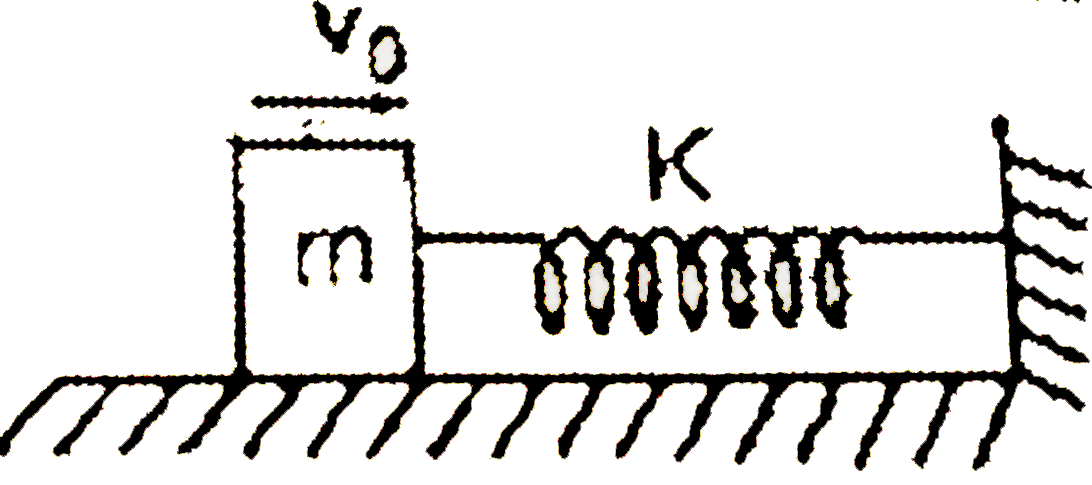A block of mass m is moving with an initial velocity v0 towards a stationary spring of stiffness k attached to the wall as shown in figure

a. Find the maximum compression in the spring.
b. Is the work done by the spring negative or positive?
The force exerted by the spring is opposite to the displacement of the block. Therefore, the work done by the spring force is negative.
Let x0 be the maximum compression in the spring, then work done by spring force on the block
W=−x0∫0kxdx=−12kx20
If we consider a block in the system. The external force acting on the block is spring force. Using work-energy theorem,
W=ΔK=Kf−Ki
⇒−12kx20=0−12mv20⇒x0=v0√mk

Topper's Solved these Questions
- WORK, POWER & ENERGYBOOK - CENGAGE PHYSICSCHAPTER - WORK, POWER & ENERGYEXERCISE - Solved Examples
15 Videos
- WORK, POWER & ENERGYBOOK - CENGAGE PHYSICSCHAPTER - WORK, POWER & ENERGYEXERCISE - Exercise 8.1
25 Videos
- VECTORSBOOK - CENGAGE PHYSICSCHAPTER - VECTORSEXERCISE - Exercise Multiple Correct
5 Videos
Similar Questions
In the fig 4.24 a block of mass m moves with velocity v0 toward a stationaly block of a mass M on a smooth horizontal surface. Find the maximum compression in the spring of stiffnesss constant K.

View SolutionA block of mass m moving at a speed v0 compresses a spring of spring constant k as shown in the figure. Find (a) the maximum compression of spring and (b) speed of the block when the spring is compressed to half of maximum compression.
View Solution
Knowledge Check
A block of mass m moving with a velocity v0 collides with a stationary block of mass M to which a spring of stiffness k is attached, as shown in Fig. Choose the correct alternative(s)
 AThe velocity of the centre of mass is v0BThe initial kinetic energy of the system in the centre of mass frame is 14(mMM+m)v20CThe maximum compression in the spring is v0√(mMm+M1k)DWhen the spring is in the state of maximum compression, the kinetic energy in the centre of mass frame is zero
AThe velocity of the centre of mass is v0BThe initial kinetic energy of the system in the centre of mass frame is 14(mMM+m)v20CThe maximum compression in the spring is v0√(mMm+M1k)DWhen the spring is in the state of maximum compression, the kinetic energy in the centre of mass frame is zeroA block of mass m moving with velocity v0 on a smooth horizontal surface hits the spring of constant k as shown. Two maximum compression in spring is
 A√2mkv0B√mk.v0C√mk.v0Dm2k.v0
A√2mkv0B√mk.v0C√mk.v0Dm2k.v0A block of mass m moving with a velocity v0 on a smooth horizontal surface strikes and compresses a spring ofstiffuess k till mass coines to rest as shown in the figure. This phenomenon is observed by two observers :
(a) Standing on the horizontal surface
(b) standing on the block

To an observer A the work done by spring force is:Anegative but nothing can be said about its mangnitudeB−12mv20Cpositive but nothing can be said about its magnitudeD+12mv20
A block of mass m sliding n a smooth horizontal surface with velocity →v meets a long horizontal spring fixed ast one end and having spring constant k as shown n figure. Find the maximum compression of the spring. Will the velocity of the block be the same as v whenit comes back to the original position shown?

View SolutionA block oc mass 'm' is moving on a smooth horizational surface with speed v0 towards a vertical wall as shown. A massless spring of stiffness 'K' is attached to the wall such that the block compresses the spring as it moves closer to the wall. The natural length of the spring is Io (i) What is the speed of the block, as the speing has been c ompressed by a distance x? (ii) What is the macimum copression produced in the spring?

View SolutionA block of mass m strikes a light pan fitted with a vertical spring after falling through a distance h. If the stiffness of the spring is k, find the maximum compression of the spring.

View SolutionA block of mass m moving with a velocity v0 on a smooth horizontal surface strikes and compresses a spring ofstiffuess k till mass coines to rest as shown in the figure. This phenomenon is observed by two observers :
(a) Standing on the horizontal surface
(b) standing on the block

To an observer B, when the block is compressing the spring :
View SolutionA block of mass m moving with a velocity v0 on a smooth horizontal surface strikes and compresses a spring ofstiffuess k till mass coines to rest as shown in the figure. This phenomenon is observed by two observers :
(a) Standing on the horizontal surface
(b) standing on the block

To an observer A, the net work done on the block is:
View Solution
